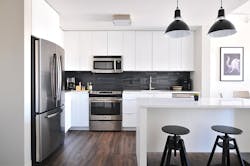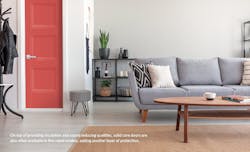Managing Noise in Open-Concept Spaces
Current design trends call for ample natural light, increasingly minimalist furniture, and open-concept floor plans. While stylish, these trends have produced an unintended consequence: fewer acoustic inhibitors and greater sound transference throughout the home.
Problems with sound can arise for spaces adjacent to open-concept rooms—often including the kitchen, dining, and living rooms. Here are three tips for managing sound transference—whether it’s noise filtering in from elsewhere or the ambient sounds of each room—and creating a quieter open-concept home for clients.
Choose Solid Core Doors
There are often fewer doors by design in open-concept homes. To maintain privacy and quiet, more homeowners opt to invest in high-quality, sound-absorbing, solid core interior doors. The substantial construction of thesedoors helps prevent sound transference more than hollow core doors. The industry is pushing for greater sound ratings on products, and product manufacturers are actively pursuing research with dedicated acousticians to develop better doors.
Texturize The Space
Consider recommending the use of textiles in open-concept spaces. While not traditionally used as a solution for improving acoustics, various textile elements—such as large, high pile rugs, artistic woven wall hangings, or luxurious drapes—can result in more sound absorption when used in a space together.
Polyester, suede, and velvet curtains have twofold benefits, providing insulation and preventing outdoor noise from contributing to the home’s ambiance. Textured, decorative wall panels can achieve a one-of-a-kind accent wall, while also reducing echo.
Advise The Selection Of Quieter Appliances
Today’s living spaces serve many purposes: The living room now encompasses the kitchen, and the kitchen accommodates the dining area. Something as simple as starting the dishwasher can produce noise interference, interrupting television, reading, conversation, and even sleep. Many companies are focusing on engineering quieter appliances specifically for open-concept demands. Make sure to offer these options to clients, especially those living in open-concept spaces.
Sound transference is not always at the top of the homeowner’s mind, trailing behind the more immediate concerns of aesthetic, quality, and function. But realizing later that specific design choices have led to a noisier home could lead to client dissatisfaction. Identifying sound-absorbing opportunities in the interior decor, such as doors or appliances, early in the remodeling process helps ensure a happier client, and a happier home.

